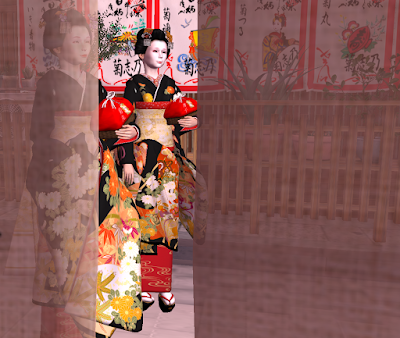After the Kyo odori, that took place in the end of April and the Misedashi of Maiko Kikushino that took place last weekend, Hanafusa okiya is finally returning to its usual schedule. The tortoise shell antique kanzashi have been returned to their boxes and formal kimono have been hidden in the wardrobe until next celebration - what will it be, Misedashi or maybe Erikae?!
Okaasan Geiko Kikuyu
 |
| Okaasan of Hanafusa okiya in her May attire |
For the last month of Spring, Kikuyu-okaasan decided on pale yellow, should i say, even cream semiformal kimono with hand-painted irises and willow. All this unique ensemble is held with obi, tied in taiko style knot. This obi is quite interesting - the background is made with black and white squares, and upon it there are flowers of asagao or morning glory. This small flower is considered summer time pattern and together with kimono gives a clear message "The spring is soon to end, prepare for summer heat".
The juban is pink and is worn by senior geiko (Kikuyu san has been geiko since 2012 so she is considered senior member of the SL Kagai). Red juban is worn by junior geiko and by any geiko during formal events.
On her feet Okaasan is wearing Senryoo geta.
Senior Maiko Kikutsuru
 |
| Atatori of Hanafusa okiya in her May attire |
Now lets look at the may kitsuke worn by Atatori(heiress) and most senior maiko in Hanafusa okiya - Kikutsuru san. The background of her hikizuri is some between green and grey, with blue and white irises. This hikizuri reminds me of a pond with wild irises blooming near - this is refreshing effect that this kimono has on a viewer. It is tied with woven obi with butterflies.
Hairstyle - Ofuku - is worn only be senior maiko. It requires different from Junior Maiko kanzashi style - 1 or 3 big flowers, worn on the right side of the front bun. Also the seasonal flowers for Senior maiko may differ from the ones worn by Junior - for example in May Senior Maiko wear Iris or can wear wisteria, while Juniors are restricted to wisteria only. Maiko in Miyagawacho start to use kushi comb right after they become Senior.
In her hand, Kikutsuru san is holding pink kago that fits the hanao silk straps on her high okobo
 |
| Senior Maiko Kikumaru of Hanafusa okiya in her May kitsuke |
After Kikutsuru san comes Senior Maiko Kikumaru, who is wearing yellow hikizuri with motif of irises and a flow. An iris by a running stream evokes the tenth century ‘Tale of Ise’: poet, who travels far, arrives at Yatsuhashi, sees irises in full bloom and is struck by such longing for his wife left in far Kyoto that he writes a verse for her beginning each line with a syllable from the flower’s name ‘ka-ki-tsu-ba-ta’(Japanese word for iris that grows on semi-wet land; ayame - iris that grows on the dry land). It is tied with greed obi that has yellow geometrical pattern. Obiage (cloth at the top of the obi) it tucked into the obi - in Miyagawacho hanamachi all maiko, who become senior do so while in other Hanamachi maiko tie obiage cloth upon their obi right till the time before erikae.
Junior Maiko Kikune
 |
| Junior Maiko Kikune wearing her May semiformal outfit |
May is also month when kimono with peony motif are worn and you can see one unique piece worn by Maiko Kikune - on the light blue silk there are pink and white peonies and upon them are golden clouds that are usually seen on the byobu screens. Also known as the ‘King of Flowers’, the peony is a symbol of good fortune, bravery and honor.
While looking at her kanzashi you may ask - why is junior Maiko wearing senior flower? In Miyagawacho, when a junior Maiko is not far from becoming Senior, she is allowed to start wearing senior Kanzashi, but with one difference - she cannot use kushi comb but the flower bridge.
In her hand she is holding a custom made kago bag with her professional name embroidered on it.
Junior Maiko Kikushino
 |
| Junior Maiko Kikushino in her May attire |
The youngest Maiko in Hanafusa okiya, Maiko Kikushino, this month will wear beautiful gradient hikizuri with hand-painted bamboo and wisteria motif. Japanese symbolism for the wisteria is:love, sensuality, support, sensitivity, bliss and tenderness. Wisteria blossom also expresses wish for good luck and even serious devotion - that is why we can see this motif on so many formal kimono.
Obi is worth a look as well - it is very colorful and fits the kimono perfectly.
Her hairstyle is called Wareshinobu, and the monthly kanzashi motif, worn by Maiko Kikushino, is wisteria or fuji.
Kikushino chan has debuted this month (11-13th of May) under the wing of Maiko Kikumaru, she is still very new, and are thankful for all the support that was given by you, dear readers and patrons.











